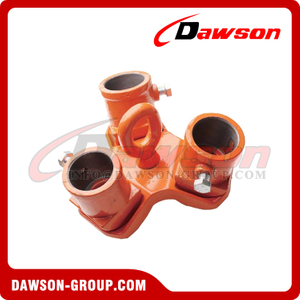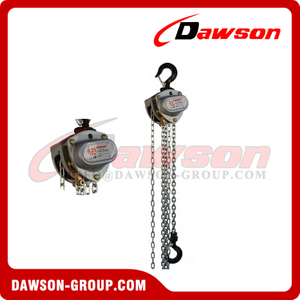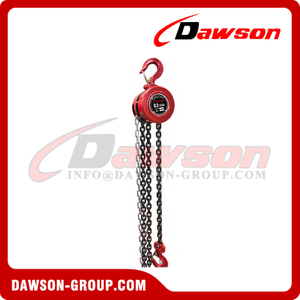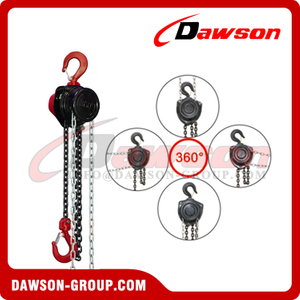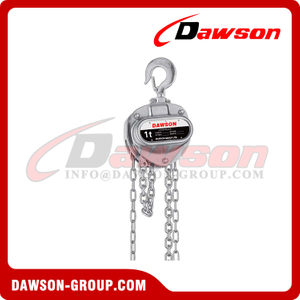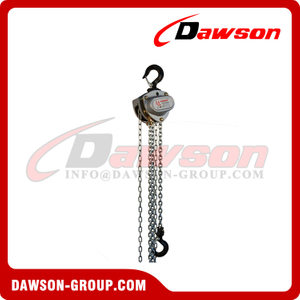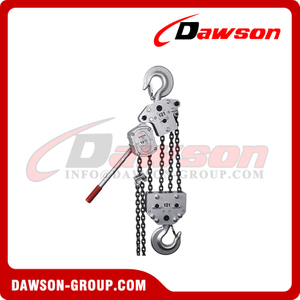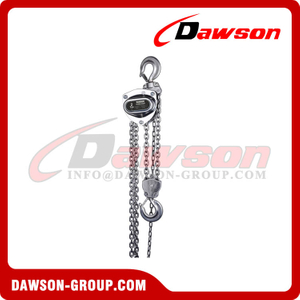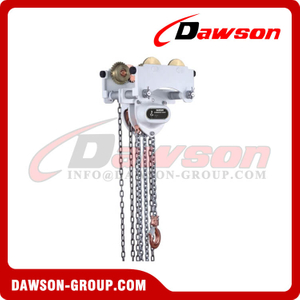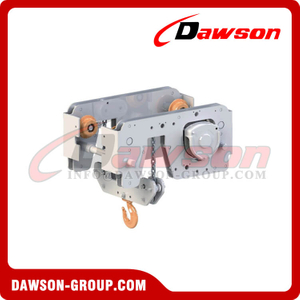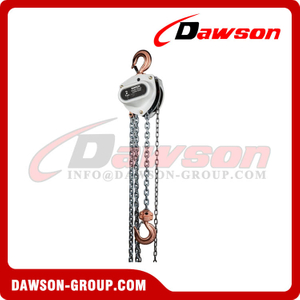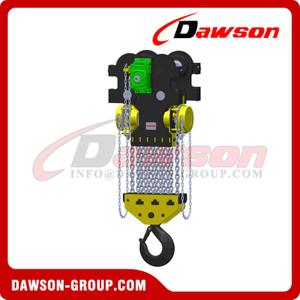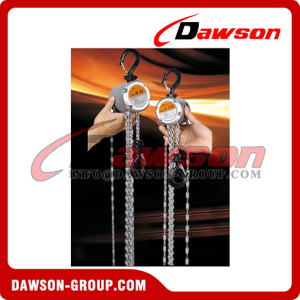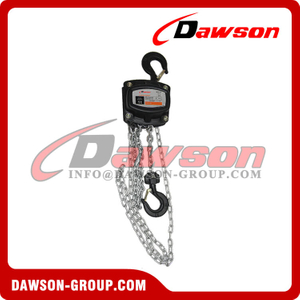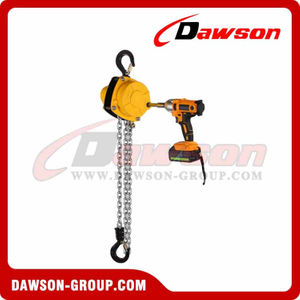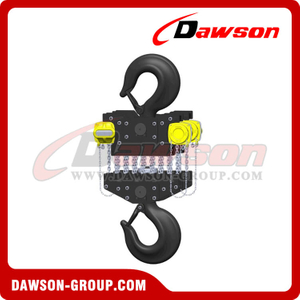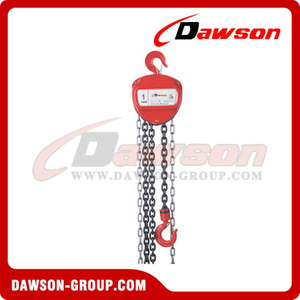- Dawson Group Ltd. - China Manufacturer, Supplier, Factory
Big capacity hand hoist can be used powerfully on the large-scale lifting work ,especially, on the building projects and installing big size equipment .
| Model | DS-CH-100T |
| Capacity load | 100000kg |
| Test load | 1250KN |
| Lifting height | 9m(2×202m) |
| Min. distance of two hooks | 3635m |
| Force | 475N×2 |
| Load chain falls | 20×2 |
| Load chain type d × p | ø10×30 |
| Hand chain type d × p | ø5×23.7 |
| Net weight | ≈3500kg |
| The weight of extra 1Mof lifting height | 84.7kg |
Welcome to buy the newest and competitive price DAWSON 100T Chain Hoist, 100000KG Manual Chain Block from our factory. We're one of the leading China manufacturers and suppliers, offering you the wholesale service and the OEM service at a discount. With CE certification, our products made in China in stock are high in quality and low in price. Please be free to get the free sample from us.
For further information, please contact us. Email:info@dawson-group.com Hot Tags: bulk 100ton chain hoist, low price 100000kg chain block, high quality 100ton chain hoist, wholesale 100000kg chain block, buy discount heavy duty chain blocks, hot sale lifting chain hoist for sale, customized chain block, cheap price manual hoist, lifting equipment China supplier, lifting chain hoist China manufacturer, chain hoist China factory, chain hoist China exporter, chain hoist in stock, chain hoist 100t free sample, chain hoist dawson brands, chain hoist OEM
Products Show:


DAWSON manual chain hoists are commonly known as chain blocks and are designed for heavy duty lifting and materials handling operations. Chain blocks raise and lower loads by pulling on the hand chain. Chain blocks can be of single or double fall configurations depending on the capacity of the block.
Chain Hoist is widely used manual hoisting machinery which is easy to use and carry. It can be used in factory, mine, agriculture, electricity, construction site, wharf and dock. And it can also be used in installing of machinery, lifting, loading and unloading in the ware house, especially suitable to be used in the open air and the place without power source.
INSPECTION BEFORE USE Ensure that the chain block name plate and WLL is clearly visible and legible.
The pre-use inspection for a chain block should include the following:
Load chain
1.Inspect chain for wear.
2.Inspect chain for gouges, nicks, arc burns, twisted & bent links and corrosion.
3.Inspect for correct reeving on multi-reeved units (3 and 5 tonne).
Lift wheels & Sheave wheels
1.Inspect lift wheel for foreign material, wear and corrosion.
2.Inspect dead end pins for wear, tightness and corrosion.
Hooks
1.Inspect hooks for signs of opening, cracking, bending, arc burns and corrosion.
2.Hooks should swivel freely.
3.Inspect safety latches for condition & operation.
4.Measure the hook throats for allowable service openings.
Hand chain
1.Inspect chain for wear.
2.Inspect chain for twisted or gouged links and corrosion.
3.Inspect connecting link for signs of opening.
Miscellaneous
1.Inspect frame and covers for distortion, cracks, gouges, corrosion & other damage.
2.Inspect hangers (3 and 5 tonne) for cracks, gouges, corrosion & other damage.
3.Inspect unit for clear WLL identity.
CARE IN USE
1.The load chain must always mesh correctly with the load sheave. With multi fall chain blocks twists can arise by turning over the bottom hook through the load chain.
2.Regularly lubricate the whole length of the load chain with machine or gear oil but be careful not to over lubricate as oil or grease on the brake discs can cause the brake to malfunction and slip.
3.Confirm that the brake is functioning properly by hoisting the load 100mm and check the brake when lowering the load.
4.Non-vertical (sideways pulling) of the hand chain is not recommended on our chain blocks.
5.The hand chain is equipped with a safety link. When the safety link opens or deforms, stop at once and inspect for the cause.
6.Confirm that the monorail beam or structure supporting the chain block is of sufficient strength to support the load to be lifted.
7.Never lift loads in excess of the WLL of the chain block.
8.Never walk or work under a hoisted load and never lift, support or transport people.
9.Use chain blocks manually only.
10.Do not permit more than one operator to pull on the hand chain at one time.
11.Lift loads correctly with proper slings and attachments. Never lift with the point of the hook and never use the load chain as a sling by back hooking.
12.Lifting a load with two chain blocks is not recommended. If the operation is unavoidable, hoist the load with utmost care, keeping the load balanced.
13.Never run the load chain out too far. When operated beyond the range of lift, an excessive load that can cause damage will be imposed on the chain block.
14.Chain blocks are designed for lifting loads vertically and should not be used for horizontal or angle hoisting.
15.Extreme temperatures will reduce the durability of the hoist. Loads should be hoisted or lowered very slowly and carefully in extreme temperatures.
16.Never leave a load hanging on the hoist.
17.Never use the chain or hook as a ground for welding.
Asbestos free brake, holding load at any desired height.
- Robust all-steel construction.
- Top and bottom hooks are fitted with safety latches as standard.
- All rotating components mounted on roller or ball bearings to reduce friction & increase efficiency.
ALWAYS:
•Ensure suspension points and anchorages are adequate for the full imposed load.
•Check the load chain/wire rope is hanging freely and is not twisted or knotted.
• Position the hook over the centre of gravity of the load.
• Check the operation of the brake before making the lift.
• Ensure the slings are secure and load is free to be lifted.
• Check the travel path is clear.
• Ensure the landing area is properly prepared.
NEVER:
• Exceed the marked SWL.
• Use the load chain/wire rope as a sling.
• Shock load the block or other equipment.
• Lift on the point of the hook.
• Overcrowd the hook with fittings.
• Permit the load to swing out of control.
• Leave suspended loads unattended.
Types of blocks
A wide range of manual and power operated blocks is available. This section of the leaflet is concerned with matters which are common to the safe use of the following listed equipment when used to lift in a vertical plane only. Pulley blocks for fiber or wire rope used with winches, hand chain blocks, chain lever hoists, power operated wire rope blocks and power operated chain blocks. The use of trolleys is often associated with blocks and these may be built in with the trolley as an integral part of the appliance, or independent with the block hung on.
Operative Training
Lifting appliances should only be used by trained operatives who understand their use and that of the associated equipment used in the lift.
Installation and Commissioning
The erection procedure will vary with the equipment and should be carried out in accordance with the suppliers instructions paying attention to the following matters:
Prior to installation inspect the equipment to ensure no damage has occurred in store or transit.
Ensure the support structure is adequate for the full loads that will imposed, is tested and marked with the SWL.
When erecting trolleys ensure they are correctly set for the beam width and that the track is fitted with end stops which engage with the trolley frame or wheel tread. The track should remain level at all loads up to the maximum.
When suspending appliances by a top hook ensure the support fits freely into the seat of the hook.
After erection ensure that the chain/wire rope hangs freely and is not twisted or knotted.
With power operated blocks the supply should be connected by a suitably Qualified Person taking account of any statutory or technical requirements (eg Electricity at Work Regulations, Pressure Systems and Transportable Gas Containers Regulations).
Test run to ensure the free and correct movement of the chain/rope. Check the operation of the brake. Check direction of control command, position and operation of travel limits and safety devices.
In-Service Inspection and Maintenance
The Provision and Use of Work Equipment Regulations 1998 and the Lifting Operations and Lifting Equipment Regulations 1998 both require that lifting equipment properly maintained.
This is an ongoing duty that falls on the user and a planned routine maintenance program will be necessary. In addition to the statutory thorough examinations by a Competent Person, regular in-service inspections should be made to find any faults and damage that might arise. If any are found they should be referred to the Competent Person. The maintenance program must meet the requirements of the manufacturers instructions and any special requirements due to the conditions of service. This may be combined with maintenance of other equipment used in association with the appliance, e.g. power feed system. Check the block and its associated equipment daily for obvious faults and signs of damage.
Safe Use of Blocks
The basic objectives of any lifting operation are to move the load to the desired location and land it safely, efficiently and without damage to the load, the equipment used or the surrounding buildings, plant etc. In addition to any specific instructions relating to the block the following general points must be observed:
o Never attempt lifting operations unless you have been trained in the use of the equipment and slinging procedures.
o Position the hook directly over the centre of gravity so that the line of pull is vertical.
o Do not use the chain/wire rope to sling the load, ie do not wrap it round the load, back hook or choke hitch.
o Do not lift on the point of the hook or overcrowd the hook with fittings.
o Never lift/lower more than the marked SWL. In the case of manual equipment if abnormally high effort is required, and with power operated appliances they fail to lift the load, or if the load slips this is an indication of too high a load or a fault - check the load and the appliance.
o Avoid unnecessary inching of power operated appliances and do not impose sudden or shock loads.
o Push rather than pull loads suspended from appliances with push/pull trolleys and if un-laden pull on the bottom hook. Never pull an appliance by the pendant control, supply cable or hose.
o Avoid sudden movement of travel motion or undue effort in pushing the load which can cause the load to swing.
o Avoid excessive or intentional use of motion limits unless they are additional limits intended for that purpose.
o Avoid running appliances against end stops.
o Do not allow anyone to pass under or ride upon the load. Never leave suspended loads unattended unless in an emergency then ensure the area is cordoned off and kept clear.
o Do not remove guards, protective covers, weather proof covers, heat shields etc without the authority of a Competent Person.
Other related products:


Application of Chain Hoist:


Factory and package:
 English
English
























